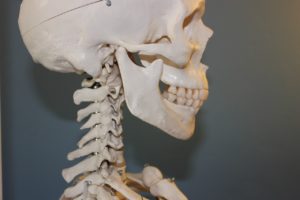
Headbones Basics
Your skull is made up of 22 bones. 2/3 of it consists of cranial bones, even though there are only 8 of them. The other 1/3 is your face.
Two main goals of the cranial bones: protects your brain, acts as an anchor for neck and face muscles.
The 8 bones are connected together by sutures (because they look like they’ve been sewn together) – and it is a tight fuse that doesn’t allow anything through.
The frontal bone – at your forehead, it’s on the FRONT. When babies are born, this bone is actually in 2 pieces to allow baby’s head to smush during delivery. It fuses together so tightly, that it becomes one bone by eight years old.
Fontanels = soft spots that babies have that allows for rapid brain and head growth. Babies have 6 total soft spots. All of them close up by 3 months old except the big one in the front.
Steve’s Story
His daughter’s soft spot would sink in and she would cry. His mother-in-law would fill her mouth with water and then suck the baby’s soft spot out. *DO NOT TRY THIS AT HOME!!*
Sunken in soft spots can be a sign of dehydration because there is lots of blood vessels in that area.
The bones in your face and head have cavities and tunnels (called sinuses) that allow nerves and blood vessels to travel through, as well as keep air pressure stable.
Questions
Question 1: Skull fracture? Can possibly happen on a suture where two bones separate, but more often an actual crack in one bone.
Question 2: Is brain bleeding always dangerous? Always potentially fatal? Yes, because your brain is closed in. Brain bleeds are classified into levels, and part of it has to do with how deep in the brain it happens, and how much pressure it puts on the things around it. Blood vessels are found all throughout your brain, and the blood that flows through them has its designated space. If the blood comes out of the blood vessels, then it starts crowding out the things around it (which can be important parts of your brain). Sometimes people may have a brain bleed and they will remove part of the skull bone to relieve the pressure.
Another Story
Orbital hemorrhage caused vision loss and feeling loss in lower extremities. If the nerve signal is interrupted temporarily, then the functions of those parts will return. If the nerves are damaged permanently, then those functions will be lost permanently. This was caused by blunt force trauma. As long as the rest of you is healthy, and the injury is fully healed, I would not expect it to happen again out of the blue.
Party Trick
Where does the bottom of your brain sit? Your cranium has a floor. One of the bones that make up the floor is called the Sphenoid bone (my favorite bone).
You can reach it and wiggle it and help with sinus pressure and drainage (it’s a neat trick!) It works by creating tiny pressure differences in your sinuses.
The outside of your skull bones are rather smooth. The inside of those bones are bumpy and jagged because it gives places for the membranes to anchor and keep the brain buoyant and centered.
Connect with me
Support us on Patreon
*NEW* Join the Pharmacist Answers Podcast Community on Facebook
Subscribe: iTunes, Stitcher, GooglePlay, TuneIn Radio
Music Credit: “Radio Martini” Kevin MacLeod (incompetech.com) Licensed under Creative Commons: By Attribution 3.0 http://creativecommons.org/licenses/by/3.0/
